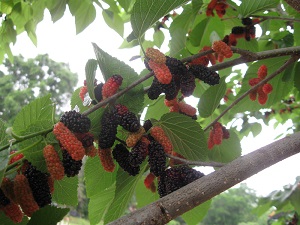Fact Sheet from
the Just Fruits and Exotics Nursery
by Brandy Cowley Gilbert
Mulberry Trees

At
one time, the Mulberry was one of the most treasured fruit trees on the
homestead. Planted around outbuildings and livestock pens, they were
valued as beautiful, useful and lush shade trees. Mulberries needed no
care, and reliably produced bucketfuls of delicious fruit. When the
berries were harvested in spring, much time was spent preserving and
storing the bounty. Opening a jar of mulberry jam or delicious dried
mulberry raisins in the depths of winter was a true pleasure. Even
spicy wines were made from the delicious and versatile Mulberry.
Mulberries prefer well-drained soils and part to full sun.
Mulberries in
the Landscape
Mulberries
make the most fabulous shade trees- tall, elegant and fast growing. Or,
for a truly cool addition to your garden, plant a weeping mulberry and
train it into a living playhouse for your kids. A simple framework and
some judicious pruning will provide a playhouse and sweet treats within
reach of the little ones at your house.
Planting and
Culture
Site Selection
Well-drained,
deep soils are preferred, but mulberry will grow on many soil types if
good drainage is provided. Trees do not tolerate flooding. Trees will
grow more vigorously and produce more fruit in full
sun.
Soil
Preparation and Planting
Mulberry
prefers slightly acid soil (pH 5.5-6.5), but soils of up to moderate
alkalinity are readily tolerated. If you are in doubt about the acidity
of your soil, take a soil sample to the Cooperative Extension Agent in
your county for a soil test. Dig a planting hole approximately three
times the width of the pot and at the same depth as the root ball. Set
that soil aside and mix it 50/50 with either aged mushroom compost,
aged manure, or rotted pine bark & aged manure/compost. Remove
the
plant from the pot, gently loosen the root ball and place in the
planting hole. To avoid burying too deep, make sure plant is positioned
with the top most roots at the soil line. Fill the planting hole with
the mix of soil and organic matter; gently tamp it in. Water thoroughly
to settle the roots and eliminate air pockets. Do NOT put fertilizer in
the planting hole. Only apply fertilizer if it is the correct time of
year (see Fertilization section below).
If desired,
construct a water basin around the base of the tree approximately 36
inches in diameter. Mulch in spring and summer with approximately 4-6
inches of mulch. Pull mulch a couple of inches away from the trunk for
good air circulation.
Fertilization
The
type of fertilizer you choose may be chemical or organic. Make sure
that the fertilizer contains iron, zinc, manganese, magnesium,
molybdenum, copper and boron. These minor elements are very important
to plants and most soils are low in these elements. Application rates
vary according to age of plant. See chart below.
10-10-10 or 10-0-10
with minerals |
1
cup per each year of tree’s life
- Max out at 9 cups for Mature tree |
Espoma
Citrus Tone
(Organic) |
6
cups for 1 year old
10 cups for 2 year old (4-6ft)
18 cups for 7-9ft tree
24 cups for tree over 9ft |
Spread the fertilizer evenly under the entire canopy of the
plant avoiding a 5-inch area around the trunk. Water or rake in. For
Zones 8a-10, fertilize 3 times each year in late February, late May and
late July/early August. For plants further north (Zones 5-7), fertilize
in March or after bud break. Never fertilize after August (June in
Zones 5-7) as this will promote new growth late in the year which will
be subject to freeze damage.
Water
The
first year is a critical time for the establishment of a new mulberry.
Water thoroughly twice a week on light soils and once a week on clay
soils. Soak the entire root system deeply – this usually takes
40-50 minutes. Mulberry trees should receive at least 1 inch of water
each week for best growth and fruit production. Water regularly,
especially during dry periods. Fruit may drop prematurely if
insufficiently irrigated during dry spells.
Pruning and Care
Mulberries
have few pests and diseases. White peach scale attacks the twigs and
trunks of trees and may kill them. Dormant oil sprays in the winter are
an effective and organic control. Trees fruit on the last flush of the
previous year’s growth. Prune in winter to remove dead, diseased
or crossing branches. Trees can also be pruned in the summer to control
the height of the trees and create thicker hedges by heading back long
branches half way. Stop summertime pruning in mid summer to allow the
tree to set next year’s fruit buds.
Harvest
Fruit
should be allowed to thoroughly ripen on the tree for best quality and
flavor. Harvest by shaking the branches over a clean sheet in May.
Mulberry Jam
Combine
9 cups crushed mulberries with 6 cups sugar. Bring slowly to a boil and
stir until sugar dissolves. Cook rapidly to, or close to, the jellying
point (depending upon whether you want soft or firm jam). As mixture
thickens, stir frequently to prevent sticking. Pour into jars and
either store in the refrigerator or process following manufacturer's
instructions. Yield: 3-4 pints
Back to
Black Mulberry Page
Red Mulberry Page
White Mulberry Page
|
|
